Are you a Quiet Speculation member?
If not, now is a perfect time to join up! Our powerful tools, breaking-news analysis, and exclusive Discord channel will make sure you stay up to date and ahead of the curve.
Welcome to the final installment of Colors of Modern! This is a five-part series of articles focused on analyzing the varying impact each color in Magic has upon Modern, based on the individual cards that see play in the format and, to a broader extent, the archetypes made possible by these cards. Check out the articles on white, blue, black, and red if you haven't already. Today, we’ll be concluding with green; analyzing its color identity in Modern along with the strengths and weaknesses associated with common archetypes that employ the color. Let’s go!
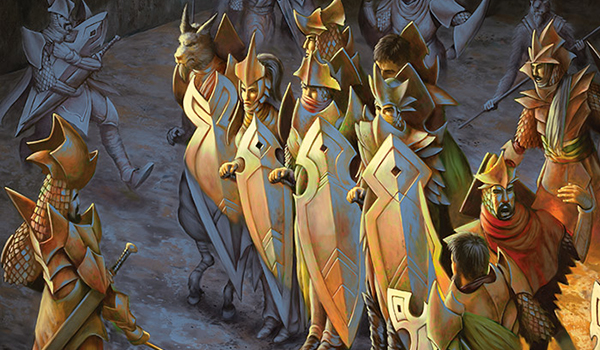
The Cards
Staples
- Noble Hierarch
- Birds of Paradise
- Tarmogoyf
- Chord of Calling
- Collected Company
- Wild Nacatl
- Glistener Elf
- Scapeshift
Strong Options
- Ancient Stirrings
- Primeval Titan
- Become Immense
- Sylvan Scrying/Sakura-Tribe Elder/Search for Tomorrow
- Eternal Witness
- Summoner's Pact
- Kitchen Finks
Sideboard Powerhouses
- Scavenging Ooze
- Obstinate Baloth
- Melira, Sylvok Outcast
- Nature's Claim
- Choke
Multi-Color
- Voice of Resurgence
- Qasali Pridemage
- Abrupt Decay
- Maelstrom Pulse
- Atarka's Command
- Destructive Revelry
- Huntmaster of the Fells
- Bring to Light
- Firespout
Green in Modern can be summed up with one word: power. Obviously there’s Tarmogoyf, the gold standard of everything in Magic, but beyond that, green benefits from the powerful ability of mana acceleration in a format defined by tempo and mana efficiency. This attribute positions green as one of the strongest colors in the format, and defines basically everything about the color. If we’re going to have a conversation about green, the absolute first place we must start is mana acceleration.
[wp_ad_camp_1]
Mana Acceleration
So, we know why mana acceleration is good in Magic, as every Magic child in history has grown up with the mantra, “Bolt the Bird.” The intricacies of this condition might be lost on some, however. About a year ago, I wrote an article for Nexus (my first article for the site) called “Mana as a Resource.” 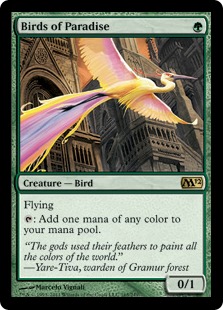 In it, I framed the context of cards that see play in Modern around tiers, organized by converted mana cost. For one mana, you get an answer, for two you get a threat, for three you get card advantage, for four you win the game. This principle guides and controls interaction in the format, based around the relative “fairness” that comes from both players having access to the same amount of mana at different points in the game.
In it, I framed the context of cards that see play in Modern around tiers, organized by converted mana cost. For one mana, you get an answer, for two you get a threat, for three you get card advantage, for four you win the game. This principle guides and controls interaction in the format, based around the relative “fairness” that comes from both players having access to the same amount of mana at different points in the game.
When one player (read: the player with mana acceleration) can break through this ceiling, advantages can be accrued at an increasing rate. The best way to explain this is through natural gameflow. On the play, we play Birds of Paradise into Liliana of the Veil, while our opponent plays a lowly Tarmogoyf on turn two. Already we’re significantly ahead, simply from our Birds of Paradise allowing us to deploy faster to the board.
The effects of mana acceleration can grow exponentially as well. We are not “just” playing a Liliana of the Veil a turn earlier, but also playing a four-drop on turn three, a three- and two-drop on turn four, et cetera.  In this way, a Birds of Paradise can generate continuous mana, pushing that advantage as far as it can go. When viewing Modern as a format based primarily around exchanges (mana exchanges, card exchanges, positioning) gaining even one free mana can often be worth the card investment. While we’re playing three-drops (generating advantages from spells like Kitchen Finks and Eternal Witness) our opponent is behind, playing one dimensional two-drops and taking time off of development to react to our board advantage.
In this way, a Birds of Paradise can generate continuous mana, pushing that advantage as far as it can go. When viewing Modern as a format based primarily around exchanges (mana exchanges, card exchanges, positioning) gaining even one free mana can often be worth the card investment. While we’re playing three-drops (generating advantages from spells like Kitchen Finks and Eternal Witness) our opponent is behind, playing one dimensional two-drops and taking time off of development to react to our board advantage.
I say all that to say this: without mana acceleration, green would be nowhere near as powerful as we see it currently. Collected Company played on Turn 4 is “fine,” but pales in comparison to the now-banned Splinter Twin. Kitchen Finks as a fair three-drop is okay, but played as a two-drop against an opposing Master of the Pearl Trident it becomes so much better. Scapeshift on turn seven is just plain horrible---on and on it goes.
Secondary Strengths
With this in mind, we can further frame green’s strength in Modern as “efficiency and power within the context of mana acceleration.” As a color, green is pushed naturally 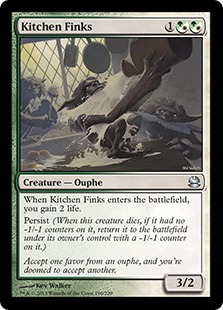 towards strong creatures and big effects, which is why we see creature decks (Abzan Company/Zoo) and ramp strategies (RG Breach, Tron) as the primary users of green spells in Modern. Naturally suited to presenting threats, green has found success in pairing strong creatures with powerful abilities. Kitchen Finks, Scavenging Ooze, Wild Nacatl, and Primeval Titan all exhibit this characteristic in slightly different ways.
towards strong creatures and big effects, which is why we see creature decks (Abzan Company/Zoo) and ramp strategies (RG Breach, Tron) as the primary users of green spells in Modern. Naturally suited to presenting threats, green has found success in pairing strong creatures with powerful abilities. Kitchen Finks, Scavenging Ooze, Wild Nacatl, and Primeval Titan all exhibit this characteristic in slightly different ways.
Green can boast library manipulation and card advantage as well, as long as we’re focusing on lands or creatures. Sylvan Scrying and the powerful Ancient Stirrings both afford the color a surprising amount of selection for a color stereotyped as being all about big dumb creatures. Chord of Calling in particular probably goes down in history as one of the best tutoring spells available in Modern, except for the late Birthing Pod (yet another green, or at least mostly green, option).
Examples
So, before moving on to the weaknesses of green in Modern, let’s take a look at some lists, shall we?
Infect, by Andrew Jessup (2nd, SCG Dallas Open)
A green “combo” deck of sorts that takes advantage of the interaction between the infect mechanic and pump spells, Infect (the archetype) best exhibits multiple aspects of green’s strength in Modern. Pump spells, cheap threats, mana acceleration; Infect has it all, and this archetype 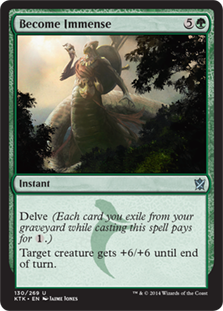 has remained at or near the top tier in the format for as long as Modern has existed.
has remained at or near the top tier in the format for as long as Modern has existed.
Those with experience in the matchup know how essential Noble Hierarch is to the archetype, as the extra mana acceleration it provides completely changes the dynamic of how turns are played with the deck. Noble Hierarch gives the archetype access to more mana than the opponent, both to more quickly deploy pump spells and “one-up” opposing removal attempts with more protection spells.
While the decks I’ve been drawn to in Modern usually boast good matchups against this archetype, I’ve always loved just how much play this archetype has to it, and how much power it can pack into cards with one converted mana cost. Become Immense doing essentially 12 damage is just gross.
Abzan Company, by Jacob Baugh (8th, SCG Dallas Open)
Probably the most traditional green deck in Modern, Abzan Company utilizes mana acceleration, powerful green toolbox-style creatures, and card advantage-generating effects and tutoring spells. Like Infect, Abzan Company has an incredible amount of play to it. It can win in multiple ways, through combat, combo-killing, or just slow generation of advantages through effects like Collected Company, Eternal Witness and Gavony Township. Again, we see mana acceleration out in force, with ten copies of Birds of Paradise and the like powering out creatures ahead of the curve and overloading opposing reactive elements. 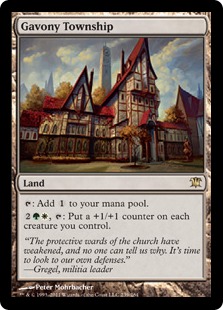 This point is essential to grasp, as Abzan Company exhibits one of the primary weaknesses of green strategies: non-interaction (at least in the maindeck). Since it must focus on maximizing the power of Chord of Calling and Collected Company, Abzan Company cannot afford to play interactive elements like Path to Exile in the maindeck.
This point is essential to grasp, as Abzan Company exhibits one of the primary weaknesses of green strategies: non-interaction (at least in the maindeck). Since it must focus on maximizing the power of Chord of Calling and Collected Company, Abzan Company cannot afford to play interactive elements like Path to Exile in the maindeck.
This carries with it a few interesting particulars. First, it must be careful of opposing threats. Dark Confidant can generate a huge advantage if allowed to remain on board for more than a few turns, which can happen should Abzan Company experience a slower draw. Opposing creature-based combo like Infect can be difficult to deal with, even though we have a maindeck killer in Melira, Sylvok Outcast. Splinter Twin, the old sentinel of Modern, is now gone, but during its reign Abzan Company was forced to play some number of Abrupt Decay/Spellskite to keep the creature-based combo strategy in check. On the other hand, removal of interactive elements from the maindeck streamlines the archetype, allowing it to compete with other fast combo decks and not immediately die. Tron is a bad matchup, but the ability to ditch dead spells makes it at least a little bit better.
RG Tron, by Justin Elkins (16th, SCG Dallas Open)
On the other side of the coin from the creature-based decks, we have green's other great contribution to the Modern pantheon of archetypes: ramp. Ancient Stirrings is one of those special cards that seems like it does absolutely nothing, yet in the right deck can be completely busted.  In Tron, Ancient Stirrings is a one-mana look at the top five cards of our library, with 85% of our deck as hits. That is truly insane, and in Tron, Ancient Stirrings is miles better than Ponder or Preordain ever were. It remains unbanned only because just a few archetypes can take advantage of it. While there are other ways to assemble Tron (due primarily to Expedition map being colorless), RG is the fastest, smoothest, most natural way to solve the puzzle, thanks mostly to Ancient Stirrings.
In Tron, Ancient Stirrings is a one-mana look at the top five cards of our library, with 85% of our deck as hits. That is truly insane, and in Tron, Ancient Stirrings is miles better than Ponder or Preordain ever were. It remains unbanned only because just a few archetypes can take advantage of it. While there are other ways to assemble Tron (due primarily to Expedition map being colorless), RG is the fastest, smoothest, most natural way to solve the puzzle, thanks mostly to Ancient Stirrings.
Ramp comes in many forms in Modern, and Scapeshift, Tron, and RG Breach all share a few similar elements, but the basic principle is the same: trade cards for mana development, with the goal being to make up for lost value with one giant spell. Tron has planeswalkers and Wurmcoil Engine, Scapeshift has Scapeshift, and Breach decks have, well, Through the Breach. Green’s naming conventions aren’t very spicy, but give them a break. English hard.
The Downsides
So, we’ve summed up green’s strengths into a few primary categories: mana acceleration and power, with some sub-tiers in the form of toolbox effects, tutoring, and pump spells. Now for the disadvantages. Green is often forced to be singularly focused on its objective, which forces its marquee archetypes to be one-dimensional and, for the most part, unsuited to interaction.
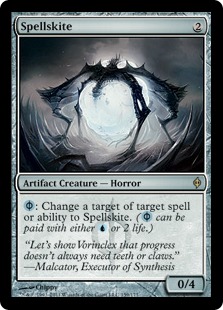 If Spellskite can’t handle it, Abzan Company tends to struggle. If Firespout isn’t enough, Tron can be in trouble. If Spellskite (again) can’t handle it, Infect tends to struggle. As far as creature removal goes, green really has none, and is forced to rely on colorless options like Dismember to get the job done. Fortunately, green rarely has problems with creatures as long as they’re one-dimensional, as Tarmogoyf is always the biggest bully on the block. However, utility creatures like Dark Confidant and Kalitas, Traitor of Ghet can be troublesome. In addition, green can fight through reactive elements like removal to an extent thanks to Collected Company and persist, but sweepers have always and will always be the bane of strategies that must commit to the board. Green doesn’t struggle as much against “weird” permanents thanks to Nature's Claim, but see the above point about one-dimensionality.
If Spellskite can’t handle it, Abzan Company tends to struggle. If Firespout isn’t enough, Tron can be in trouble. If Spellskite (again) can’t handle it, Infect tends to struggle. As far as creature removal goes, green really has none, and is forced to rely on colorless options like Dismember to get the job done. Fortunately, green rarely has problems with creatures as long as they’re one-dimensional, as Tarmogoyf is always the biggest bully on the block. However, utility creatures like Dark Confidant and Kalitas, Traitor of Ghet can be troublesome. In addition, green can fight through reactive elements like removal to an extent thanks to Collected Company and persist, but sweepers have always and will always be the bane of strategies that must commit to the board. Green doesn’t struggle as much against “weird” permanents thanks to Nature's Claim, but see the above point about one-dimensionality.
Conclusion
Green contains a formidable amount of power and versatility to secure its position as one of the strongest colors in Modern. Thanks primarily to mana acceleration and Tarmogoyf, green has a strong base that sees it included in “best-of” archetypes like Jund and Junk. Green has more than proven itself capable of sponsoring archetypes based primarily on its color, however, and Elves, Abzan Company and Infect demonstrate the depth green exhibits in Modern. Where other colors struggle due to lack of sideboard options, Nature's Claim and other effects give it a solid amount of play in post-board games. In the end, green is hindered primarily by a lack of strong removal options, but more than makes up for it with linear strategies that ignore or sidestep this inherent weakness.
And with that, our Colors of Modern series is concluded! Through writing the series I gained a new, clearer perspective of each color’s identity in Modern---what makes them work, their strengths, and their weaknesses. I hope I was able to pass that along in the writing. Some of the articles fell a little short in a few areas, but overall I enjoyed writing the series and hope you enjoyed reading!
I’m back from Rome as of Tuesday and looking forward to getting back to format analysis. I've also officially returned to streaming consistently, so drop by and say hello!
Thanks for reading, and I’ll see you next week!
Trevor Holmes
The_Architect on MTGO
Twitch.tv/Architect_Gaming
Twitter.com/7he4rchitect






I feel as though, as objective and simplified as this innately is, that some cards on the “strong options” list, like Tasigur and Kitchen Finks, are prevalent across many lists, whereas in the same colors, Scapeshift and, to a lesser degree Inquisition, are only seen in one or two decks.
I agree. Glistener Elf is listed as a staple, and Kitchen Finks isn’t? Finks is the number two creature in modern and G Elf is only played in infect.
Hey guys,
Thanks for the response! I detailed my “classification philosophy” last week with Red and thought about copying it over but decided against it. From last week:
Staples, in my mind, are unquestionably powerful spells that are considered auto-inclusions in certain archetypes (and powerful elsewhere) or enable whole archetypes by themselves. Lightning Bolt needs no explanation, as it is ever-present in the format and many archetypes stretch to red just to play Bolt, but almost everything else can be argued as stronger or worse than another option. The line between staple and strong option here is very blurred.
While Kitchen Finks is more prevalent in the format, if I was forced to classify it I would consider it just a “strong option” and not a “staple” as it’s not clearly the best option out of similar cards that perform relatively similar tasks for the mana. Whereas something like Scapeshift provides the best effect for the mana cost (compared to other four mana “ramp” spells like Oracle of Mul Daya or the like). Obviously not the cleanest comparison, but when comparing the “necessity” of something like Glistener Elf or Scapeshift to Kitchen Finks, that’s where I chose to draw the line.
Hope this helps, and if not, let me know if you still disagree! Thanks for the feedback!
Trevor
It would be great if you could continue the series also for Artifacts. Even though you already treated Multi-Colour cards as part of the colours, why not also spend an whole articel about them?
Also want to use the opportunity to tell you that Modern Nexus really developped into something providing good information and analyzes – keep on going with that! Would be great if you could also do some more content on magic finance.
hey you forgot about a lot of the elves, heritage druid, nettle sentinel, lannowar, etc. they is an entire deck based around them. also missing chameleon colossus from side board cards.
over all really well written though, quite enjoy the series.
also happy you’re streaming again.